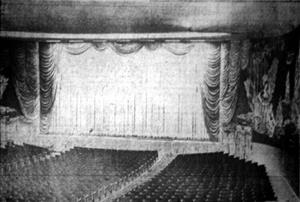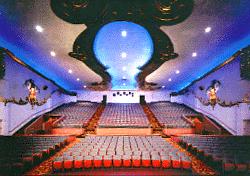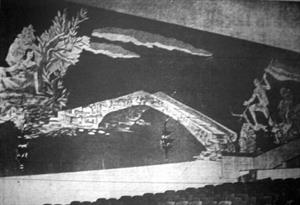The Villa Opens

Deseret News, page C6, 18 December 1949
The Villa was built in 1949 by Joseph L. Lawrence and David K. Edwards at a cost of $350,000. Construction began September 1948, with Carl S. Fors Co. as general contractor, and was completed 17 December 1949. The architect was A. B. Poulson.
Special emphasis was given to making the theater comfortable and aesthetically pleasing. Straight lines were avoided in favor of curves and "inorganic shapes." 3000 square yards of velvet drapes in pastel shades covered the screen. Vast murals, in light pale colors against a dark red background, brightened the walls of the auditorium with scenes of women at work in agricultural pursuits and men fishing.
Originally the lobby had a a planting box of native flagstone instead of a concession stand. The lobby also once held a "montage" of Utah scenery, constructed of copper-colored metals, artificial cedar leaves, wood, fabrics and plastics. The central figure in the montage was a "sophisticated-looking woman," which the artist said was his impression of the "Utah girl."
A sunken waiting room, with "attractively designed chairs and divans," gave access to the restrooms. The women's lounge, or powder room, had individual dressing tables and an entire wall of mirrors. The "smoking" room, which gives access to the men's restroom, was done in distinctive "male" colors.
"The building - not a drive-in - will seat about 1300 persons in a "stadium" arrangement, a new theater layout plan successfully utilized in two new model theaters recently built at Los Angeles, Cal. In this layout, the front half of the theater is level and the rear half of the auditorium built on a rather steep incline. The entranceway is beneath the "riser," as is common in football stadiums."[1]

Cathy Kelly
Courtesy of thecrest.com
The seats were described as the "latest type," meaning they were "constructed so they spring back into position after the patron leaves." The rows were set three inches father apart than usual to make it possible for showgoers to "enter and leave without disturbing others in the same row".
The Villa's original screen was 26 feet wide, "one of the largest in the West," and was located on the stage. In 1953 and larger screen was installed for the CinemaScope presentation of The Robe. The screen most familiar to Villa patrons is the 96-foot Cinerama screen that was installed in 1961.
More Info: History of the Villa's Screen
The main entrance to the theater had three "massive" double doors. The doors were made of glass, or "herculite," and were protected by "sashes of stainless steel". Sometime after the 1996 remodeling, these doors were destroyed by a traffic accident which sent a motorcycle crashing into the the theater lobby.
The island marquee was 32 feet high and 29 feet long, and contained 2000 "pulsating" 40-watt bulbs and 1400 feet of fluorescent tubing. The circular marquee, above the theater entrance, was lighted by hundreds of feet of neon, plus 44 150-watt spot globes. Both marquees were installed and designed by Young Electric Sign Corp.
A couple of the key advertising features of the Villa was free parking and air conditioning. The theater had a lighted, 2.5 acre parking lot that could accommodate 500 cars. The air-conditioning system drew its cold water from a deep well on the site.
On 20 December 1949, a Tuesday, the Villa showed MGM's Battlefield to a preview audience. Mayor Earl J. Glade spoke before the showing and "all congratulated the management on having one of the most up-to-date and modern theaters in the area."
The Villa opened to the public on 23 December 1949, showing Prince of Foxes along with the Uptown theater in downtown Salt Lake. Ticket prices before 5 P.M. are 50 cents for adults and 14 cents for children. Evening showings are 75 cents for adults and 20 cents for children.

Deseret News, page C6, 18 December 1949
1. "Bids Asked for S. L. Theater To Cost $350,00, Seat 1300", Salt Lake Tribune, 22 August 1948, page S8
